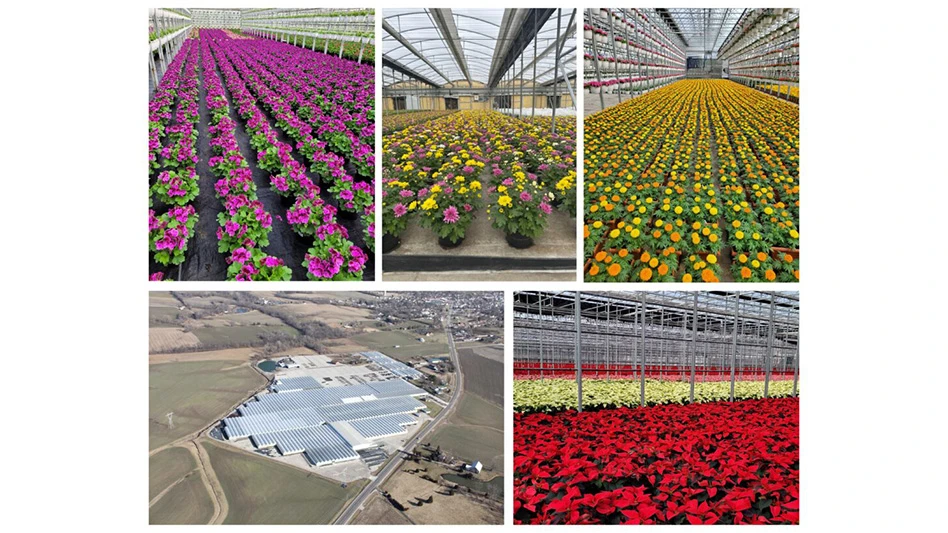
Aphids are major insect pests of greenhouse-grown horticultural crops including ornamentals and vegetables. One of the most common aphid species encountered in greenhouses is the green peach aphid, Myzus persicae (Figs. 1 & 2), which feeds on >400 plant species in 40 different plant families. Green peach aphid causes direct plant damage by withdrawing plant fluids from the phloem sieve tubes with their piercing-sucking mouthparts, resulting in leaf distortion, plant stunting and plant wilting. Indirect damage is associated with the production of honeydew (clear sticky liquid) and transmission of plant viruses during feeding. In addition, a short generation time and high female reproductive capacity allows green peach aphid populations to quickly reach damaging levels.
Insecticide resistance
Therefore, insecticides are routinely applied to suppress green peach aphid populations (Fig. 3). However, the short generation time and high female reproductive capacity of the green peach aphid also contribute to their propensity to develop resistance to insecticides. As such, the intensive use of insecticides to manage green peach aphid populations has resulted in populations that are currently resistant to a number of insecticide classes. In fact, the continual reliance on insecticides and subsequent intensive selection pressure has led to green peach aphid populations developing multiple resistance mechanisms that have enhanced resistance to most chemical classes including: organophosphate, carbamate, pyrethroid and neonicotinoid. Currently, the green peach aphid has developed resistance to >70 different compounds. Furthermore, the green peach aphid is able to overcome the toxic effects of insecticides based on six different resistance mechanisms.

These resistance mechanisms confer resistance to different chemical classes (indicated in parentheses) and are affiliated with: 1) overproduction or enhanced production of detoxification enzymes that break down the active ingredient before reaching the target site in the central nervous system (organophosphates, carbamates and pyrethroids); 2) changes or mutations in specific enzymes that decrease sensitivity to certain insecticides by modifying the target site (carbamates); 3) changes in the voltage-gated sodium channels (pyrethroids); 4) over-expression of detoxification enzymes (neonicotinoids); 5) reduced penetration through the cuticle (neonicotinoids); and 6) changes or alterations in the target receptor sites (neonicotinoids).

Most resistance mechanisms are associated with increased or enhanced production of metabolic detoxification enzymes or modification of target receptor sites in the central nervous system, resulting in reduced sensitivity. Moreover, several resistance mechanisms may be present, thus resulting in green peach aphid populations that are resistant to multiple insecticides with different modes of action. Some of these mechanisms evolved early in response to plant chemical defenses or plant-derived toxins and have been manifested after exposure to insecticides. Furthermore, the green peach aphid is a generalist herbivore and has a greater propensity to develop resistance to insecticides due to the presence of a variety of resistance mechanisms that confer resistance to plant chemical defenses or plant-derived toxins. In fact, some insecticides have similar properties to plant-derived toxins. For instance, the pyrethroids are synthetic derivatives of pyrethrins, which are natural components of the chrysanthemum, Tanacetum cinerariifolium, flower. As such, similar resistance mechanisms can confer resistance to pyrethrins and pyrethroids.
Another type of resistance mechanism is referred to as “behavioral avoidance,” which confers resistance to neonicotinoids. Behavioral avoidance is associated with green peach aphids spending more time on untreated leaves than treated leaves. Aphids will disperse away from insecticide-treated leaves. For instance, the green peach aphid tends to avoid residing and feeding on leaves treated with imidacloprid and will move to untreated leaves. However, it should be noted that imidacloprid does have repellent activity, so “behavioral avoidance” may not solely be responsible for resistance.

Mode of action types
There are two mode of action types associated with insecticides: narrow and broad-spectrum. Narrow-spectrum (site-specific) modes of action insecticides are active on specific target sites such as the central nervous system or enzymes associated with metabolism. Broad-spectrum mode of action insecticides are active on a variety of target sites or possess multiple modes of action. For example, some of the more “selective” insecticides such as pymetrozine (Endeavor), flonicamid (Aria) and cyantraniliprole (Mainspring) may be less prone to resistance due to their broad-spectrum modes of action compared to insecticides with narrow-spectrum modes of action. In fact, pymetrozine exhibits no cross resistance (based on a single resistance mechanism conferring resistance to pesticides in the same chemical class and/or having similar modes of action) to either pyrethroid or carbamate insecticides.
The best way to mitigate resistance is to rotate insecticides with different modes of action throughout the growing season when green peach aphid populations are present. Table 1 presents a list of some insecticides that are labeled for use against aphids and their designated mode of action.

Explore the November 2018 Issue
Check out more from this issue and find your next story to read.
Latest from Greenhouse Management
- Terra Nova Nurseries introduces rust-free and disease-resistant heucherella
- John T. Nickel, founder of Greenleaf Nursery Co., passes away at 89
- Three tours offered at 2025 Farwest Show
- Garden Media Group announces sixth annual Women in Horticulture Week
- Star Roses and Plants announces National Knock Out Rose Day
- The Growth Industry Episode 4: How federal budget cuts are affecting horticulture nonprofits
- The thrips battle plan
- Pennsylvania Horticultural Society shares top gardening trends from 2025 Philadelphia Flower Show





